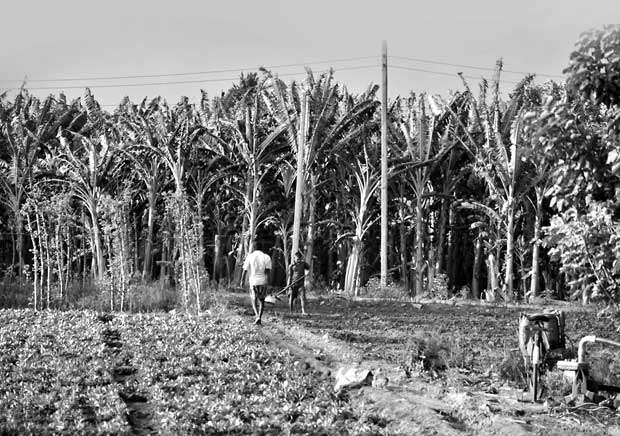Reply To:
Name - Reply Comment
Last Updated : 2024-04-19 00:03:00
For close to three decades, the people of the North and East were wedged in by war, uprooted from their lands by multiple displacements, and shut off from the market, being forced to survive on subsistence production and humanitarian subsidies. Once the war ended, they were thrown without preparation into a monetized and financialised market economy. 
Economic reintegration has been fraught by exploitative loan schemes and unrealistic state or donor-led livelihood programmes. The so-called “livelihoods” on offer, such as raising chickens, tailoring, handicraft production and other problematic modes of self-employment have sucked the population dry with many even losing their meagre emergency assets of gold jewellery to the pawn brokers and micro-finance schemes of the financial industry.
Thanks to the protests and struggles of mainly rural women from the North and East, the severity of indebtedness has gained national attention, and the flawed character of the micro-finance model for rural development laid bare. Even so, the broader economic situation of these deprived people, their exclusion from economic opportunities, lack of regular incomes, and crippling poverty and malnutrition, remain neglected. In this article, I draw on Karl Marx’s concept of a relative surplus population to analyse the economic predicament of the northern population.
In Capital Volume 1, Marx describes the predicament facing the working population as follows:
“The relative surplus population exists in all kinds of forms. Every worker belongs to it during the time when he is only partially employed or wholly unemployed. Leaving aside the large-scale and periodically recurring forms that the changing phases of the industrial cycle impresses on it, so that it  sometimes appears acute, in times of crisis, and sometimes chronic, in times when business is slack, we can identify three forms which it always possesses: the floating, the latent, and the stagnant.”
sometimes appears acute, in times of crisis, and sometimes chronic, in times when business is slack, we can identify three forms which it always possesses: the floating, the latent, and the stagnant.”
Marx is concerned here about capitalist accumulation and its consequences, and speaks of the relative surplus population in relation to the absolute labour needs of capitalist production. Marx is addressing the economic dynamics facing the proletarian population that was pushed out of the countryside into the towns as a work force, where a section of them were spat out into becoming a stagnant and even pauperized population. In the case of northern Sri Lanka, it is the dynamics that threw a war-torn population into a neo-liberal globalized economy that has made even subsistence difficult.
The stagnant and pauperized population in the North share certain broad characteristics. They are often landless, either absolutely landless without even housing land or lacking utilizable plots of agricultural land in the countryside. They mostly belong to oppressed caste communities and for generations have been excluded from formal employment, better avenues of education and other state services.
With labour force participation the lowest in the Northern Province, a significant section of the population in the North remains excluded from any meaningful avenues for production and income generation. In particular, women with dependants and youth lack accessible and sustainable economic opportunities.
"The stagnant and pauperized population in the North share certain broad characteristics. They are often landless, either absolutely landless without even housing land or lacking utilizable plots of agricultural land in the countryside"
For youth, employment and income generation opportunities are limited to the exploitative garment industry and seasonal wage labour. Young women who enter the newly created garment factories in the North find employment is insecure, exploitatively hard on the body and are squeezed out of the jobs before their benefits increase and mature. Youth who take up unskilled day wage labour, find that work is irregular, influenced by seasonal and weather patterns including more recently the long drought, and the whims of market demand for production.
Unplanned mechanization of agriculture has had ripple effects. Labour used in the past for harvests is no longer needed with the introduction of paddy harvesting machines. Mechanized harvesting has also undermined secondary production relating to hay including the production of cattle feed. While the investment in harvesting machines, including many bought on leasing arrangements, may not be financially feasible due to the small scale of production and leading possibly to the bankruptcy of those who purchase such expensive machinery, the nett impact is one of reducing the demand for and immobilizing of labour.

Even possibilities for subsistence production are limited owing to the monetization of the rural economy. Poverty-stricken households in rural Jaffna utilise as much as 15% of their incomes on purchasing firewood for cooking. In other words, there are fewer avenues for the absolute landless and those living on marginal plots of land to forage for firewood, vegetables and green leaves—unlike earlier generations, their economic lives are now increasingly monetised and cash is necessary for survival.
State support for rural production also increasingly emphasizes production for cash and exports. For example, fisheries development policies focus on aquaculture production including in seaweed and sea cucumber. Such production does not contribute towards subsistence, and ends up transferring the downside risks of production disruption and market fluctuations to rural households who desperately enter these export-oriented rural development schemes. In deprived rural households devoid of subsistence, during difficult seasonal times, they do not even cook their main lunch-time meal of rice.
What will become of the marginalized war-torn population of the North and East? Capital exploits them and spits them out as with the garment industry and dispossesses them through financial mechanisms including pawning and micro-finance. The state also dispossess them by grabbing land and coastal resources for its mega development projects and environmental conservation programmes of the Forest and Wildlife Departments as well as by pushing people into unsustainable self-employment and livelihood schemes. Pauperized or on the brink of poverty, state and donor schemes such as for poverty alleviation pull them up a notch for a period of time, keeping the population in the painful dynamics of floating, latent and stagnant economic life.
The marginalized war-torn population, inevitably requires local and rural economic alternatives. Land for the landless, and the strengthening of communities through the redistribution and granting of land is one such avenue as their pauperisation is directly linked to landlessness. Strengthening producer co-operatives including in fisheries, livestock, crafts such as carpentry and palmyrah-related production is another avenue to strengthen communities of producers and the incomes they earn.
Avenues for regular incomes, including through re-distributive schemes that also contribute to local rebuilding, such as the National Rural Employment Guarantee Scheme in India where each household was guaranteed one hundred days of rural work every year, is another possibility. However, the search for such alternatives require recognition of the crippling economic reality facing a section of our citizenry and listening carefully to their long ignored struggles.

Add comment
Comments will be edited (grammar, spelling and slang) and authorized at the discretion of Daily Mirror online. The website also has the right not to publish selected comments.
Reply To:
Name - Reply Comment
On March 26, a couple arriving from Thailand was arrested with 88 live animal
According to villagers from Naula-Moragolla out of 105 families 80 can afford
Is the situation in Sri Lanka so grim that locals harbour hope that they coul
A recent post on social media revealed that three purple-faced langurs near t

10 Apr 2024
09 Apr 2024